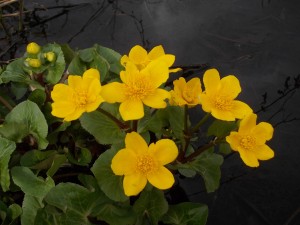
Even as I arrived the weather looked threatening. The sun sparkled dramatically off the water, under a magnificently dark cloud, making the marsh marigolds gleam golden against the almost-black water.
From the hide, redshanks could be seen scurrying about; some lapwings energetically chased off a few carrion crows, and a few snipe wandered about, right out in the open, ceaselessly probing the mud for food. Even better, the first little ringed plover of the year came out on to the marsh, flying off suddenly, its narrow wings flashing. The lapwings’ territoriality is valuable to other nesting birds, like the little ringed plover, as it protects their nests from predators of eggs and young like the crows. Lose the lapwings, as we have done across most of England – there are hardly any wet meadows left – and you lose much more. Drain and fertilise the meadows, and coarse grasses outgrow all the delicate flowers: you lose both the beauty and the bees, and the bees matter as they pollinate crops. The farmers hardly noticed they had done anything: after all, they only did a few sensible things to the land. That’s how delicate the ecological balance is.
The rain arrived, sweeping in on a cold wind that whistled through the hide windows, spattered camera lenses and binoculars with fat raindrops. In a minute, every window was closed, everyone happy to be in a warm dry place. I focused the telescope on a snipe and watched it while the rain threw up splashes all around it. Every minute or two it shook itself, keeping its feathers dry and fluffed up to maintain its insulation – clearly its plumage is nowhere near as oily and waterproof as a duck’s. But it went on feeding, its legs in the chilly water, its long beak in the mud, or retracted and rapidly opening and closing as it swallowed its catch. Living and feeding on a marsh means being cold and wet most of the year, really.
In the distance on the open water, three or four newly arrived sand martins swooped to catch insects from the surface, dashing about like the tiny brown tailless swallows that they are – I was watching them through the telescope (not something that often works well with fast birds like swallows), gently swinging from side to side to follow them as those watching with binoculars tried to count how many there were, little fastmoving specks against the water. We were all enjoying some wildlife, small as matchboxes, over a hundred metres away, flying in the rain. It was a very light, happy atmosphere in the hide, with nobody in a hurry, all the talk on the birds we could just about see. Really, it was perfect.
